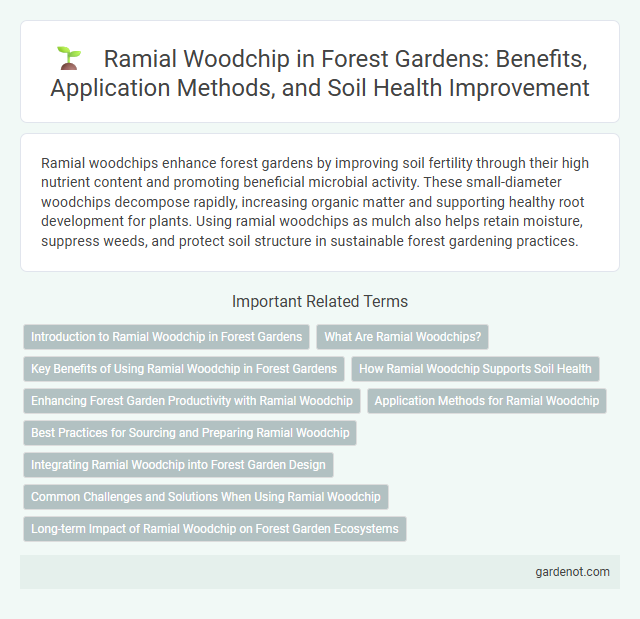Ramial woodchips enhance forest gardens by improving soil fertility through their high nutrient content and promoting beneficial microbial activity. These small-diameter woodchips decompose rapidly, increasing organic matter and supporting healthy root development for plants. Using ramial woodchips as mulch also helps retain moisture, suppress weeds, and protect soil structure in sustainable forest gardening practices.
Introduction to Ramial Woodchip in Forest Gardens
Ramial woodchip, derived from small branches of deciduous trees, is a nutrient-rich mulch essential for forest gardens. Its high concentration of nitrogen, lignin, and cellulose enhances soil fertility, promotes beneficial microbial activity, and improves moisture retention. Incorporating ramial woodchip supports sustainable forest garden ecosystems by fostering healthy root development and increasing organic matter.
What Are Ramial Woodchips?
Ramial woodchips are small branches and twigs primarily derived from deciduous trees, typically less than 7 centimeters in diameter. These woodchips are rich in nutrients and beneficial microorganisms, making them ideal for enhancing soil fertility and structure in forest gardens. Their high lignin and cellulose content promote slow decomposition, improving organic matter and moisture retention in the soil over time.
Key Benefits of Using Ramial Woodchip in Forest Gardens
Ramial woodchip enriches soil fertility by providing a rich source of nitrogen and beneficial microorganisms that accelerate organic matter decomposition in forest gardens. This nutrient-dense mulch improves moisture retention and suppresses weed growth, promoting healthier plant development and reducing maintenance efforts. Its application supports sustainable nutrient cycling and enhances soil structure, leading to increased biodiversity and long-term ecosystem resilience.
How Ramial Woodchip Supports Soil Health
Ramial woodchips, derived from young branches rich in nutrients and beneficial microbes, enhance soil structure by increasing organic matter and moisture retention. Their high lignin and cellulose content encourages diverse microbial activity, promoting nutrient cycling and improving soil fertility. Applying ramial woodchips as mulch reduces erosion, suppresses weeds, and fosters a robust forest garden ecosystem by sustaining healthy, living soil.
Enhancing Forest Garden Productivity with Ramial Woodchip
Ramial woodchips, derived mainly from young branches and twigs, significantly enhance soil fertility and structure in forest gardens by increasing microbial activity and nutrient availability. Their high nitrogen content and rapid decomposition promote vigorous root growth and improve moisture retention, leading to healthier plants and higher yields. Applying ramial woodchips as mulch or soil amendment optimizes forest garden productivity by fostering a sustainable, nutrient-rich environment.
Application Methods for Ramial Woodchip
Ramial woodchip, composed mainly of young branches and twigs, is applied as mulch in forest gardens to enhance soil fertility and moisture retention. Spreading a 5-10 cm thick layer around plants helps suppress weeds, improve microbial activity, and gradually release nutrients essential for tree and shrub growth. Incorporating ramial woodchips into pathways and planting beds promotes sustainable soil health by increasing organic matter and supporting beneficial soil organisms.
Best Practices for Sourcing and Preparing Ramial Woodchip
Sourcing ramial woodchip requires selecting small-diameter branches, preferably less than 7 cm in diameter, from deciduous trees rich in nutrients and lignin to maximize soil health benefits. Preparing the woodchip involves shredding fresh green branches promptly to preserve moisture and microbial activity, avoiding dry or aged material that can slow decomposition. Applying a thin layer of ramial woodchip around plants enhances nutrient cycling, improves soil structure, and supports beneficial microbial populations essential for a thriving forest garden ecosystem.
Integrating Ramial Woodchip into Forest Garden Design
Integrating Ramial Woodchip (RWC) into forest garden design enhances soil fertility by supplying a rich source of nutrients and improving microbial activity essential for plant growth. Applying RWC as mulch around trees and perennial shrubs reduces moisture loss, suppresses weeds, and promotes beneficial mycorrhizal fungi. Strategic placement of Ramial Woodchip supports resilient, sustainable forest garden ecosystems by mimicking natural forest floor conditions and facilitating nutrient cycling.
Common Challenges and Solutions When Using Ramial Woodchip
Common challenges when using ramial woodchip in forest gardens include nitrogen immobilization, slow decomposition rates, and potential pest attraction. To overcome nitrogen immobilization, it is effective to combine woodchips with nitrogen-rich materials like green manures or compost. Regular monitoring and adjusting mulch thickness can accelerate decomposition and reduce pest issues, ensuring optimal soil health and plant growth.
Long-term Impact of Ramial Woodchip on Forest Garden Ecosystems
Ramial woodchip application significantly enhances soil structure and nutrient cycling in forest garden ecosystems by accelerating the decomposition of organic matter and increasing microbial biodiversity. Over the long term, this practice improves soil moisture retention and promotes robust tree root development, fostering resilient plant growth and higher yields. Continuous input of ramial woodchips also contributes to carbon sequestration, supporting ecosystem stability and mitigating climate change effects.
Ramial woodchip Infographic

 gardenot.com
gardenot.com